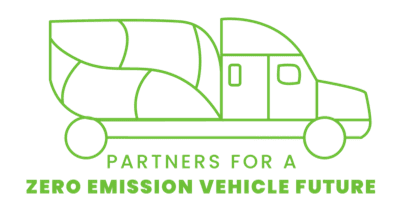As governments worldwide turn to zero-emission vehicles (ZEVs) to decarbonize their economies, the concept of the inflection point — at which consumer demand overtakes public policy as the main driver of ZEV demand — has become a critical milestone. Momentum is growing in the U.S. for public policy that moves ZEV adoption toward the inflection point, including in the medium- and heavy-duty (MHD) vehicle sector.
This transition is supported by Partners for a Zero-Emission Vehicle Future (PZEVF). Formed by the four largest truck manufacturers in North America — Daimler, Navistar, Paccar, and Volvo Group — PZEVF is a growing coalition of stakeholders from across the transportation sector united by a commitment to support the adoption of MHD ZEVs and minimize transportation emissions. To achieve this, PZEVF advocates for policies that create the conducive environment needed for MHD ZEV adoption to reach the inflection point — one that is, ultimately, backed by an inherently more efficient nationwide approach.
PZEVF knows that ZEVs are the future of commercial transportation, enabling us to meet a diverse array of climate, air quality, environmental justice, and economic goals. However, to ensure this transition happens swiftly, effectively, and in a manner that brings fleets large and small with it, more must be done at both the state and federal levels.
The Trucks are Here…
Encouragingly, the breadth and availability of electric commercial vehicle options has grown significantly in recent years. From only a handful of options, there are now more than 100 different MHD ZEVs available made by more than 50 manufacturers, from school buses and delivery vans to drayage trucks, street sweepers, and refuse trucks. Even during the COVID-19 pandemic, model availability increased 26% between 2020 and 2022 according to Calstart.
Such increases in availability and demand are coming as states adopt shorter timelines for the ZEV switch. In August last year, California passed the Advanced Clean Trucks Rule (ACT Rule), which mandates ever greater proportions of Class 2-8 vehicle sales to be ZEVs between 2024 and 2035. By 2035, zero-emission truck/chassis sales would need to be 55% of Class 2-3 truck sales, 75% of Class 4-8 straight truck sales, and 40% of truck tractor sales. Other states, including New York, Massachusetts, Oregon, Washington, and New Jersey, have followed suit and adopted the ACT Rule.
Similarly, California is also in the process of considering the Advanced Clean Fleets Rule (ACF Rule) as another mechanism to accelerate the market for MHD ZEVs. The California Air Resources Board is expected to finalize that regulation in Spring 2023, mandating increased ZEV purchases by fleets in addition to modifying the ACT to require MHD ZEV sales to reach 100% by 2040.
…But the Infrastructure is Not
Yet despite the growing ZEV market and increased impetus toward ZEV adoption by state governments, challenges still remain. The most critical of these is getting the charging infrastructure in place to meet the ZEV transition ambitions.
Even California, which has invested billions of dollars over several years to create an environment conducive to ZEV adoption, has a lot of work to do if it hopes to meet its own goals. There are only 306 battery electric trucks on California’s roads today, but there are 56,000 required to be on the state’s highways by 2026 and to meet those goals, almost 50,000 new high-power charge ports are needed — or nearly 900 per month — in addition to the grid infrastructure upgrades required to handle an estimated 2GW of additional load demand for these vehicles.
While the California Energy Commission and several of the state’s utilities have made funding available for MHD ZEV charging, many other states that have adopted tight MHD ZEV timelines have not. Without the requisite infrastructure, we run the risk of making fleets adopt ZEVs, but have nowhere to charge them — with an unintended consequence of keeping diesel trucks on the road for longer.
Creating the Right Environment
Despite the challenges, there are steps that states can take now to create the conducive environment for ZEV adoption. To begin, they can take advantage of significant federal funding through the Infrastructure Investment and Jobs Act (IIJA), which has prioritized sustainability as a key component of rebuilding our nation’s infrastructure. A key plank of this is the National Electric Vehicle Infrastructure (NEVI) Formula Program: a $5 billion program, consisting of $1 billion in funding per year from 2022-2026, to help states build out the necessary infrastructure for the ZEV transition. Currently, states are only prioritizing light-duty ZEVs in the first round of NEVI funding. But in the coming years, states should include MHD-specific charging in their NEVI plans, as well as other charging corridor projects.
In addition, the timelines for charging infrastructure deployment – from siting and trenching to final installation – must be shortened. As a result, states should expedite permitting for charging infrastructure. Even for light-duty vehicles, where the momentum for electrification is greater than MHD ZEVs, a myriad of zoning laws and permitting regulations means some municipalities are taking 12 months to approve the installation of a single DC fast charger. And while some cities and counties are now expediting the process for light-duty vehicles, it must be replicated for medium- and heavy-duty vehicles as well. If states want to meet their MHD ZEV adoption goals, red tape should not hold them back.
We can also catalyze the MHD ZEV switch by offering incentives to offset higher purchase prices. To begin, states could exempt commercial ZEVs from sales taxes, in addition to offering upfront rebates for purchases of electric trucks like those offered in California’s HVIP program. Utilities should also work with fleets to develop equitable time of use rates, make-ready programs, and evaluate load estimates for electric charging that will require grid improvements along freight corridors and at transportation hubs.
Leading the Way: Washington State
One state that others can look at for guidance on policies to foster electrification, and advocacy that draws diverse stakeholders together for a common goal of ZEV deployment, is Washington State. Its recently-passed cap and trade program — which the state is terming as cap and invest — will generate significant funds that will then be used for vehicle electrification and charging infrastructure development. The state’s Department of Ecology anticipates the program, which will go live in February next year, will be the “cornerstone” of its policy efforts to reduce carbon emissions in communities statewide and build a transportation system that achieves the state’s zero-emission goals.
Helping to advocate for policies such as this is Clean and Prosperous Washington (CaPWA), a broad-based coalition of environmental groups, energy companies, local employers and equity advocates. CaPWA is working at the state level to accelerate the transition to a clean economy with prosperity for all.
Michael Mann, executive director of CaPWA, notes that “because transportation is Washington’s largest source of greenhouse gases, and medium- and heavy-duty vehicles account for a significant share of those GHGs, we see an opportunity to decarbonize freight and goods movement, and to improve air quality in overburdened communities with incentive programs to transition to zero emission technology.” He added, “As we advocate for medium and heavy-duty ZEV incentive programs in Washington, we’re pleased to have PZEFV as a key partner in this coalition. The collective expertise of the traditional truck OEMs will be valued by all.”
Momentum and demand for ZEV trucks in the U.S. is on the rise, but despite this progres,s there are still significant challenges to overcome before commercial ZEV growth reaches its inflection point. Every state has much to do if it hopes to have the charging infrastructure to match and maintain their medium- and heavy-duty ZEV goals. However, despite these obstacles, there is the political will to do it, and in the case of Washington state, the right suite of policies and partnerships are working diligently to make the commercial ZEV shift a lasting reality.
For more information on Partners for a Zero Emission Vehicle Future, visit pzevf.org



